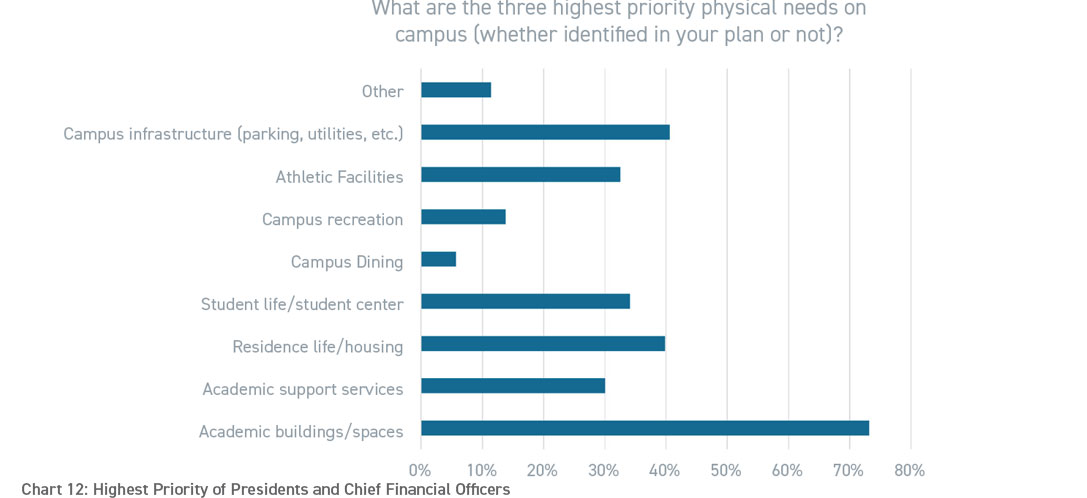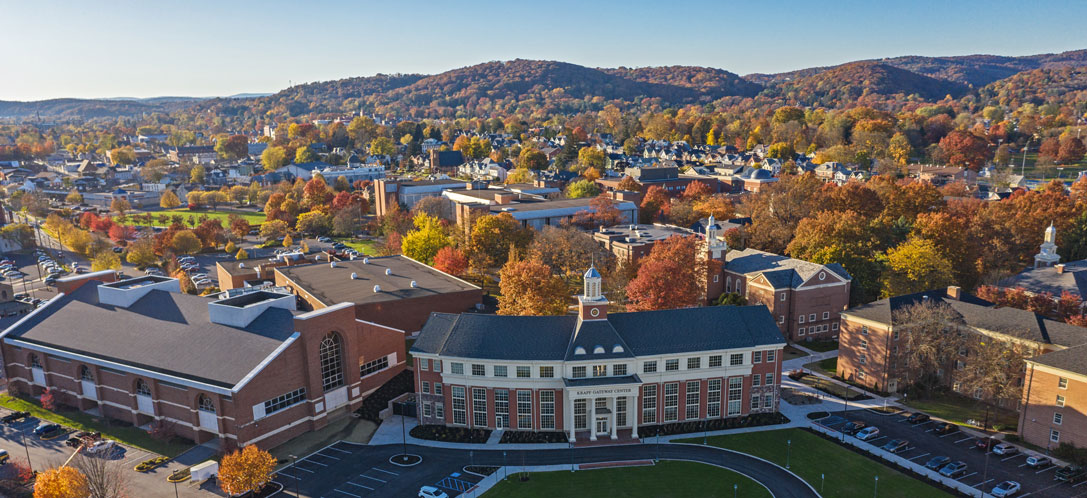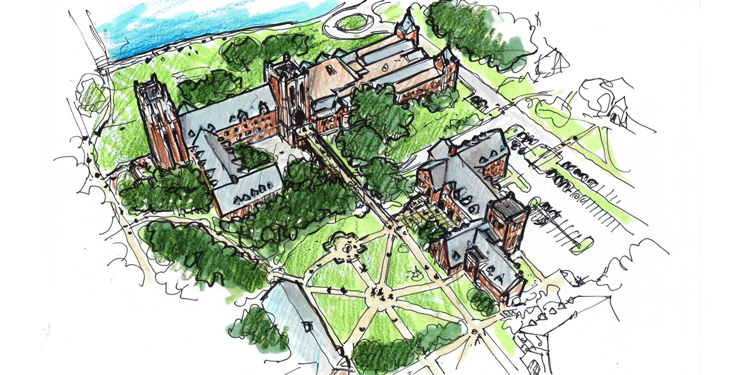
Research on Campus Master Planning - A Survey of Presidents and Chief Financial Officers

The landscape of American higher education has been in a constant state of flux. Over just the past few decades, colleges have seen enrollments peak and bottom out, student demographics have shifted, technological innovation and lessons learned during the pandemic have forever changed pedagogical delivery and student expectations, and the business model upon which colleges and universities have relied upon has proven at best to be unreliable and at worst, failing.
Just 20% of college executives report their donors are very enthusiastic about their campus master plan.
The diverse and unpredictable headwinds of the modern era have pushed campus executives to confront hard truths as they develop strategies that exhibit an astute stewardship of resources and advance the mission. The conventional five-year strategic plan that once served postsecondary education well seems to fall short in responding to the pace and pressures of the common era. Often, these strategic plans were untethered to a far distant, expensive, and ambitious campus master plan if, in fact, a campus master plan existed at all.
Given these realities, BHDP’s research team recently sought to assess the viewpoint of college presidents and chief financial officers as it relates to campus master planning and strategy. BHDP’s intent was to equip postsecondary leaders with data to help inform and make more effective their campus planning efforts.
In Fall 2022, BHDP surveyed presidents and chief financial officers at US colleges and universities. This survey, completed by 124 presidents and CFOs at private and public institutions, asked a series of questions relating to the development of their most recent campus master plan, its timeframe for implementation, and whether it aligns with the institution’s three to five-year strategic plan or priorities. It also asked these campus executives the likelihood that the campus master plan would be substantially implemented, how enthusiastic the board and donors are about the campus master plan, the three highest priority physical facility needs on campus, and the primary source of funding to address these priorities. Finally, the survey assessed if presidents and CFOs believed strategic planning and master planning should be more integrated and cover the same timeframe.
Among respondents, 42% work at four-year private institutions, 27% work at community colleges, 10% work at four-year public institutions, 8% are employed at private for-profit institutions, with 13% listing themselves as undefined (Chart 1). Sixty-four percent of respondents work at institutions with enrollments of less than 2,500 students, and 84% of respondents work at institutions who have enrollments less than 5,000 students (Chart 2).


Upon completion of the survey, BHDP hosted a roundtable of campus presidents and CFOs to unpack the survey findings and provide additional insights into how they approach developing strategy and campus plans in today’s era. Among the six colleges participating in the roundtable, all had recently completed strategic planning processes or revised existing strategic plans. Four of the six colleges have recently completed or are in the process of completing new master plans.
Participants

Reverend Dr. Eric Zimmer
President
University of Saint Francis

Allan Mark
Executive Vice President for Administration, Finance, and Operations
Belmont Abbey College

Susan Burns, PhD.
President
College of Mount Saint Vincent

Dennis McMaster
Vice President for Finance, Chief Financial Officer
West Virginia Wesleyan College

Stefanie Niles, Ed.D
President
Cottey College

Clair Knapp
Chief Business Officer, Vice President for Finance
Manchester University

Paul Orban, AIA, NCARB
Facilitator, Partner
BHDP
Master Planning Perceptions

When asked to describe in a word or phrase what comes to mind when they think of master planning, Presidents and CFOs offered the following advice and tongue-in-cheek comments:
ACHIEVABLE and REALISTIC: Master plans today must be visionary but also be practical based on the needs of the institution and the resources available.
PURPOSE-DRIVEN: Master plans cannot be a randomized collection of pet projects of interest to trustees, a president, or a management team. They must be tied to the strategic plan.
HEALTHY CONFLICT: Master planning should create excitement but also confront hard truths about the genuine needs of the community.
FRAUGHT: The thought of master planning is daunting given the perception of time and resources required and a sentiment that master plans all too often do not materialize.
OPTIMISTIC…BUT PERHAPS DELUSIONAL: Master planning can express an aggressive and captivating vision for the institution, but left untethered to existing needs, a strategic plan, or prospective resources, may appear to be a pipedream.
Survey Data Analysis
"A study of master planning across the postsecondary landscape illustrates the tale of two worlds, where it’s either a priority, or it’s not."
As shown by chart 3, nearly 50% of schools report completing a master plan within the past five years, but nearly 20% indicate their institutions have no master plan, with another 17% reporting their plans are more than ten years old.

Of those respondents who have a master plan, nearly 63% indicate their timeframe for implementation is less than ten years, with 27% stating their goal is to implement the master plan within the next five years. Only 18% indicate their master plans will be implemented beyond ten years (see chart 4). Some may suggest respondents present as overly optimistic and ambitious, which may, in fact, be the case. Regardless, it’s clear that presidents and CFOs, though mindful of the long-term campus needs, are very much focused on the “here” and “now”. This may be a direct correlation to the challenges facing so many institutions with declining enrollments, deteriorating facilities, and pressures to maintain mission while changing the business model.
Though mindful of long-term planning, the days of master planning for 20+ years out appear to be over. Presidents and CFOs are focused on the ‘here’ and ‘now.’

"Remarkably, only half of Presidents and CFOs believe their master plan aligns with their strategic plan. Equally concerning, only half believe their master plan will substantially be implemented."
As shown on charts 5 and 6, only 50% of respondents believe their master plan aligns with the institution’s strategic plan or priorities over the next three to five years, with only 56% believing it was likely the master plan would substantially be implemented. Nearly a quarter of respondents report their master plans are out of alignment with their strategic priorities, and 20% report they have no master plan whatsoever. This is somewhat striking, considering that over 90% of respondents, as shown by chart 7, believe strategic planning and master planning should be integrated and cover the same time period.


In reflecting on why so many institutional leaders fail to believe their master plans will substantially be implemented, one roundtable participant suggested that many colleges lack the discipline to stay focused on a campus plan that ties directly to the strategic plan. They also cited the criticality of developing momentum since securing funding isn’t easy, and the community of donors and supporters needs to see evidence that the college is having success with its mission and its plan.

When asked why they felt strategic planning and master planning weren’t integrated despite this being ideal, our roundtable of presidents and chief financial officers made a few insightful observations. First, they cited that accrediting agencies require colleges to have a strategic plan but not a master plan. Second, they reflected on the fact that some colleges feel comfortable leading a strategic planning process internally at relatively low cost, whereas most colleges lack any institutional competency to complete a master plan independently, requiring considerable investment from outside experts.
A preponderance of respondents state that progress toward completing the master plan has been somewhat limited (see chart 8). This may be a consequence of overly ambitious master planning or the existence of an aging master plan that is divorced from the dynamic changes taking placed on campuses across the country these past few years.
Of respondents who have a master plan, nearly 60% report that less than 25% of the plan has been completed.

"Presidents and CFOs report enthusiasm for their campus master plan amongst trustees and donors is relatively low, despite the fact that 61% identify philanthropy as the primary funding source to accomplish critical needs within their plan."
Resource limitations and enthusiasm among boards and donors are likely contributing to the challenges of making progress on the master plan. For example, as shown on chart 9, of those institutions who have a master plan, only 31% (or 26% of all) of presidents and CFOs believe their board is very enthusiastic about the campus master plan.

Even more concerning, when asked about the enthusiasm among donors, only 20% of presidents and CFOs who have a current master plan report their donors are very enthusiastic about the plan, and 23% simply don’t know if their donors are enthusiastic about the plan (see chart 10). This data suggests a substantial disconnect in communicating the vision and needs for the physical campus of the institution by presidents to the primary funding source who will address such needs. Especially since 61% of respondents state funding for such projects will come from philanthropy and 25% reporting funding for such needs must come through strategic partnerships (see chart 11).
Roundtable participants, when confronted with this data, suggest this lack of trustee and donor enthusiasm may be connected to a lack of purpose-driven vision being embedded within the strategic plan and master plans of the institution. They also suggested that trustees and donors may be fatigued and suspect having spent decades of watching campus presidents develop and espouse lofty “pie in the sky” master plans that have little chance of being funded or coming to fruition.


Roundtable participants unanimously agreed that in 2023, operating budgets generally cannot materially advance the campus master plan. An era of increased tuition discounting, declining enrollments, diminishing revenues, and compounding deferred maintenance leave little room within an operating budget to invest in visionary physical facility initiatives.
The participants also widely agreed that master planning projects would be accomplished through philanthropy and securing strategic partners who can share the investment burden. The notion that colleges today need to “collaborate to compete” was discussed, wherein institutions partner with other institutions to create efficiencies, reduce risk, and generate positive net revenue sooner from new initiatives.
Assuming debt to complete master planning projects was also discussed, with participants in varying positions to assume such debt. For example, some participants have governing bodies that restrict the assumption of additional debt, whereas others held balance sheets or had bylaws allowing for a responsible consideration accessing debt instruments, such as floating a bond. The point was made that certain aspects of master planning may be unappealing to strategic partners or donors yet still essential to campus infrastructure, thus requiring such debt financing.
“Presidents and CFOs identify academic buildings as the highest priority physical need on campus. This contrasts with recent research on Chief Enrollment Officers who believe residence hall renovations and student recreation spaces are the single most important physical facility upgrades to drive enrollment.”
In addition to this current survey of presidents and chief financial officers, BHDP recently surveyed chief enrollment officers. In both instances, respondents were asked to identify what they believed to be the highest priority physical facility needs on campus (see charts 12 and 13). Interestingly, enrollment officers identified residence halls and recreation spaces to be the most impactful renovations or enhancements that could drive enrollment. Yet, presidents and chief financial officers identified academic spaces as being most critical. There may be several reasons for this dichotomy, but one explanation may be that chief enrollment officers are more mindful of a prospective student’s priorities and what resonates during admission tours, whereas presidents and chief financial officers may be more focused on how the campus plan is addressing academic innovation and new program development.


How the Board can Help or Hinder the Master Planning Process

“Noses in, Fingers Out”
Roundtable participants widely agreed that presidents and management teams need to maintain thoughtful conversations about current and future use of space with their boards of trustees. This can, at times, be complex as presidents and trustees balance their roles between governance and management, which is made more difficult when some institutions have two-tiered boards.
There was also wide consensus that boards must help remove roadblocks as the management team seeks to achieve key elements of the master plan. This includes embracing their fiduciary and generative responsibilities to secure proper funding for such projects and to have sound board by-laws, real estate, and debt policies, among other key considerations.
Generally speaking, there was consensus that boards cast the mission and vision for the institution, but presidents and their management teams carry the responsibility of developing a framework for deploying this vision, including developing the master plan that will ultimately be approved by the board.
Roundtable participants discussed the philosophy of “noses in and fingers out” when characterizing how trustees should approach their role of governance. However, given the current headwinds and distress confronting many institutions, it was noted that at times of great challenge, the trustees may need to have “elbows and knees all the way in.” This captures the delicate balance presidents and trustees find themselves in and raises the importance of constant self-reflection as the board and management team assesses their proper role addressing key issues facing the institution.

So Now What?
The pandemic and resulting uncertainty and disruption in higher education has exposed a critical issue for presidents, trustees, and campus planners—is the campus strategy for spaces and buildings still aligned with the strategic mission, vision, and immediate needs of the institution? Additionally, can the campus community build consensus among current and desired stakeholders in a nimble, efficient way to implement and benefit from these spaces and facility adaptations and improvements for immediate return on investment?
We believe now is the perfect time to focus the institution’s limited time and resources on the physical investments that will allow them to implement their strategies within the timeframe needed to make an impact. Based upon BHDP’s recent research, we offer the following items to consider as you embark on strategic planning and campus master planning:
- First and foremost, we recommend an integrated strategic planning process focused on the close alignment of the academic strategy and the campus master plan. By aligning and focusing the physical campus “imperatives” on elements of the academic and financial plan that will drive results (attract students, retain students, grow academic programs, increase residential population, create mutually beneficial connections to donors and business partners, etc.), more impactful and implementable goals will be established.
- Plan for a realistic timeline. The speed of change has made ten and 20-year master plans obsolete. Consider a timeframe of three to five years, allowing for plans to evolve as external influencers evolve.
- Audit your admissions tour. What is the experience for potential students and their families? What ‘first impressions’ can be added or improved? Prioritizing elements that will form the initial impressions of prospective students and families will create a more memorable experience and have a greater likelihood of being implemented.
- Engage a broader group of stakeholders. Our research indicates alarming low enthusiasm from Trustees and potential donors. Building consensus around the master plan priorities with these groups, including focus groups and one-on-one discussions, is critically important to institutional advancement efforts.
- Ultimately, each institution must answer the question, “are these the right priorities to advance our collective campus community and be sustainable for the future?” and build consensus around the plan.
Selecting a strategic partner that prioritizes integrated planning, leads a collaborative campus planning process focused on achieving results, and understands the “business of Higher Education” can help campus leaders navigate the recommendations above. BHDP offers a no-fee initial consultation with campus leaders to discuss these key issues as well as other opportunities to help institutions improve their campus experience. Paul Orban, Principal and Market Leader for Higher Education, can be reached at [email protected].
Author
Content Type
White Paper
Date
March 01, 2023
Market
Topic
Campus Planning



